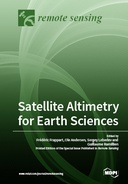Explore

Satellite Altimetry for Earth Sciences
0 Ungluers have
Faved this Work
Login to Fave
Satellite altimetry is a radar technique for measuring the topography of the Earth’s surface. It was initially designed for measuring the ocean’s topography, with reference to an ellipsoid, and for the determination of the marine geoid. Satellite altimetry has provided extremely valuable information on ocean science (e.g., circulation surface geostrophic currents, eddy structures, wave heights, and the propagation of oceanic Kelvin and Rossby waves). With more than 25 years of observations, it is also becoming vital to climate research, providing accurate measurements of sea level variations from regional to global scales. Altimetry has also demonstrated a strong potential for geophysical, cryospheric, and hydrological research and is now commonly used for the monitoring of Arctic and Antarctic ice sheet topography and of terrestrial surface water levels. This book aims to present reviews and recent advances of general interest in the use of radar altimetry in Earth sciences. Manuscripts are related to any aspect of radar altimetry technique or geophysical applications. We also encourage manuscripts resulting from the application of new altimetric technology (SAR, SARin, and Ka band) and improvements expected from missions to be launched in the near future (i.e., SWOT).
This book is included in DOAB.
Why read this book? Have your say.
You must be logged in to comment.
Rights Information
Are you the author or publisher of this work? If so, you can claim it as yours by registering as an Unglue.it rights holder.Downloads
This work has been downloaded 561 times via unglue.it ebook links.
- 233 - pdf (CC BY-NC-ND) at Unglue.it.
Keywords
- ACC
- ALES
- ALES retracker
- altimetry
- Aral Sea
- Argo
- calibration
- Classification
- coastal altimetry
- CryoSat-2
- CryosSat-2 SAR
- Data processing
- dielectric permittivity
- Discharge
- drifting orbit
- Envisat
- ERS-2
- evaporation
- filtering
- fine scale
- Fram Strait
- FVCOM
- Geodesy
- geodetic orbit
- Gravity Recovery and Climate Experiment (GRACE)
- Greenland Sea
- Hong Kong coast
- HY-2A
- hydrology
- Ice
- inland water
- Inner Niger Delta
- Jason-2
- K-medoids
- Ka-band
- lake level
- lake volume
- Landsat
- leads
- marine gravity
- Mekong Basin
- microwave radiometer
- numerical modelling
- ocean geostrophy
- ocean tides
- oceanography
- orbit decay
- peakiness
- PISTACH
- polar ocean
- radar altimetry
- range precision
- retracking
- ROMS model
- SAR
- SARAL
- satellite altimeter
- satellite altimetry
- satellite geodesy
- sea surface height
- sensor calibration
- Sentinel-3
- soil moisture
- South China Sea
- southern ocean
- space gravity
- stack data
- storm surge
- Streamflow
- SWOT
- SWOT simulator
- tide gauge
- topography of the intertidal zone
- two-layer ocean model
- unsupervised classification
- upper layer thickness
- Validation
- water level
- water level time series
- water levels
- water volume transport
- waveform
- waveform retracking
- western Mediterranean Sea
- wet path delay
- wet tropospheric correction
- X-TRACK
Links
DOI: 10.3390/books978-3-03897-681-3Editions


